Environmental Safety Assessments of Lipid Nanoparticles Loaded with Lambda-Cyhalothrin
Abstract
:1. Introduction
2. Materials and Methods
2.1. Materials
Preparation and Characterization of Lipid Nanoparticles (LN)
2.2. Environmental Safety Assessment of LN–LC on Terrestrial Organisms
2.2.1. Test Soil
2.2.2. Assessment LN–LC Safety to Terrestrial Plants Growth
2.2.3. Assessments of LN–LC Safety to Soil Invertebrates
Reproduction Test with F. candida
Avoidance and Reproduction Tests with E. fetida
2.2.4. Assessments of LN–LC Safety to Soil Microbial Parameters
2.3. Statistical Analysis
3. Results and Discussions
3.1. Physicochemical Characterization of LN
3.2. Assessment of LN Environmental Safety
4. Conclusions
Supplementary Materials
Author Contributions
Funding
Institutional Review Board Statement
Informed Consent Statement
Data Availability Statement
Conflicts of Interest
References
- Grillo, R.; Fraceto, L.F.; Amorim, M.J.B.; Scott-Fordsmand, J.J.; Schoonjans, R.; Chaudhry, Q. Ecotoxicological and Regulatory Aspects of Environmental Sustainability of Nanopesticides. J. Hazard. Mater. 2021, 404, 124148. [Google Scholar] [CrossRef]
- Khandelwal, N.; Barbole, R.S.; Banerjee, S.S.; Chate, G.P.; Biradar, A.V.; Khandare, J.J.; Giri, A.P. Budding Trends in Integrated Pest Management Using Advanced Micro- and Nano-Materials: Challenges and Perspectives. J. Environ. Manag. 2016, 184, 157–169. [Google Scholar] [CrossRef] [PubMed]
- Ghormade, V.; Deshpande, M.V.; Paknikar, K.M. Perspectives for Nano-Biotechnology Enabled Protection and Nutrition of Plants. Biotechnol. Adv. 2011, 29, 792–803. [Google Scholar] [CrossRef] [PubMed]
- Nair, R.; Varghese, S.H.; Nair, B.G.; Maekawa, T.; Yoshida, Y.; Kumar, D.S. Nanoparticulate Material Delivery to Plants. Plant Sci. 2010, 179, 154–163. [Google Scholar] [CrossRef]
- Moore, M.T.; Locke, M.A. Experimental Evidence for Using Vegetated Ditches for Mitigation of Complex Contaminant Mixtures in Agricultural Runoff. Water. Air. Soil Pollut. 2020, 231, 140. [Google Scholar] [CrossRef]
- Kim, D.Y.; Kadam, A.; Shinde, S.; Saratale, R.G.; Patra, J.; Ghodake, G. Recent Developments in Nanotechnology Transforming the Agricultural Sector: A Transition Replete with Opportunities. J. Sci. Food Agric. 2018, 98, 849–864. [Google Scholar] [CrossRef] [PubMed]
- Walker, G.W.; Kookana, R.S.; Smith, N.E.; Kah, M.; Doolette, C.L.; Reeves, P.T.; Lovell, W.; Anderson, D.J.; Turney, T.W.; Navarro, D.A. Ecological Risk Assessment of Nano-Enabled Pesticides: A Perspective on Problem Formulation. J. Agric. Food Chem. 2018, 66, 6480–6486. [Google Scholar] [CrossRef] [PubMed] [Green Version]
- Food and Drug Administration Guidance (FDA). FDA-2017-D-0759: Drug Products, Including Biological Products, That Contain Nanomaterials—Guidance for Industry. 2022. Available online: https://www.fda.gov/regulatory-information/search-fda-guidance-documents/drug-products-including-biological-products-contain-nanomaterials-guidance-industry (accessed on 20 June 2022).
- Sharma, A.; Baldi, A. Nanostructured Lipid Carriers: A Review Journal of Developing Drugs. J. Dev. Drugs 2018, 7, 1000191. [Google Scholar] [CrossRef]
- Severino, P.; Andreani, T.; Jäger, A.; Chaud, M.V.; Santana, M.H.A.; Silva, A.M.; Souto, E.B. Solid Lipid Nanoparticles for Hydrophilic Biotech Drugs: Optimization and Cell Viability Studies (Caco-2 & HEPG-2 Cell Lines). Eur. J. Med. Chem. 2014, 81, 28–34. [Google Scholar] [CrossRef] [PubMed]
- Pallerla, S.M.; Prabhakar, B. A Review on Solid Lipid Nanoparticles. Int. J. Pharm. Sci. Rev. Res. 2013, 20, 196–206. [Google Scholar] [CrossRef]
- Graily-Moradi, F.; Hejazi, M.J.; Enayati, A.A.; Hamishehkar, H. Evaluation of Co-Nanoencapsulation Process on the Toxicity and Biochemical Metabolism of Imidacloprid and Lambda-Cyhalothrin in Myzus Persicae (Sulzer). Biocatal. Agric. Biotechnol. 2021, 33, 101974. [Google Scholar] [CrossRef]
- Oudou, H.C.; Hansen, H.C.B. Sorption of Lambda-Cyhalothrin, Cypermethrin, Deltamethrin and Fenvalerate to Quartz, Corundum, Kaolinite and Montmorillonite. Chemosphere 2002, 49, 1285–1294. [Google Scholar] [CrossRef]
- European Food Safety Authority (EFSA). Outcome of the Consultation with Member States, the Applicant and EFSA on the Pesticide Risk Assessment for Lambda-Cyhalothrin in Light of Confirmatory Data; EFSA Supporting Publication: Parma, Italy, 2020; Volume 17. [Google Scholar] [CrossRef]
- De Souza, A.L.R.; Andreani, T.; De Oliveira, R.N.; Kiill, C.P.; Dos Santos, F.K.; Allegretti, S.M.; Chaud, M.V.; Souto, E.B.; Silva, A.M.; Gremião, M.P.D. In Vitro Evaluation of Permeation, Toxicity and Effect of Praziquantel-Loaded Solid Lipid Nanoparticles against Schistosoma Mansoni as a Strategy to Improve Efficacy of the Schistosomiasis Treatment. Int. J. Pharm. 2014, 463, 31–37. [Google Scholar] [CrossRef]
- ISO 10390:2020; Soil, Treated Biowaste and Sludge—Determination of pH. International Organization for Standardization Guideline: Geneva, Switzerland, 2020.
- FAOUN (Food and Agriculture Organization of the United Nations). Physical and Chemical Methods of Soil and Water Analysis; FAOUN: Rome, Italy, 1984; Volume 10, pp. 1–275. [Google Scholar]
- Soil and Plant Analysis Council. Soil Analysis: Handbook of Reference Methods; Soil and Plant Analysis Council: Boca Raton, FL, USA, 2000. [Google Scholar] [CrossRef]
- ISO 11268-2:2012; Soil Quality—Effects of Pollutants on Earthworms—Part 2: Determination of Effects on Reproduction of Eisenia Fetida/Eisenia Andrei. International Organization for Standardization Guideline: Geneva, Switzerland, 2012.
- OECD. Test No. 227: Terrestrial Plant Test: Vegetative Vigour Test, OECD Guidelines for the Testing of Chemicals; Section 2; OECD Publishing: Paris, France, 2006. [Google Scholar] [CrossRef] [Green Version]
- OECD. Test No. 232: Collembolan Reproduction Test in Soil, OECD Guidelines for the Testing of Chemicals; Section 2; OECD Publishing: Paris, France, 2016. [Google Scholar] [CrossRef]
- ISO 17512-1:2008; Soil Quality—Avoidance Test for Determining the Quality of Soils and Effects of Chemicals on Behaviour—Part 1: Test With Earthworms (Eisenia Fetida and Eisenia Andrei). International Organization for Standardization Guideline: Geneva, Switzerland, 2008.
- OECD. Test No. 222: Earthworm Reproduction Test (Eisenia Fetida/Eisenia Andrei), OECD Guideline for the Testing of Chemicals; Section 2; OECD Publishing: Paris, France, 2016. [Google Scholar] [CrossRef]
- Robinson, C.; Schinner, F.; Ohlinger, R.; Kandeler, E.; Margesin, R. Methods in Soil Biology. J. Ecol. 1997. [Google Scholar] [CrossRef]
- Eivazi, F.; Tabatabai, M.A. Phosphatases in Soils. Soil Biol. Biochem. 1977, 9, 167–172. [Google Scholar] [CrossRef]
- Tabatabai, M.A.; Bremner, J.M. Use of P-Nitrophenyl Phosphate for Assay of Soil Phosphatase Activity. Soil Biol. Biochem. 1969, 1, 301–307. [Google Scholar] [CrossRef]
- Schinner, F.; von Mersi, W. Xylanase-, CM-Cellulase- and Invertase Activity in Soil: An Improved Method. Soil Biol. Biochem. 1990, 22, 511–515. [Google Scholar] [CrossRef]
- Kandeler, E.; Gerber, H. Short-Term Assay of Soil Urease Activity Using Colorimetric Determination of Ammonium. Biol. Fertil. Soils 1988, 6, 68–72. [Google Scholar] [CrossRef]
- Berg, P.; Rosswall, T. Ammonium Oxidizer Numbers, Potential and Actual Oxidation Rates in Two Swedish Arable Soils. Biol. Fertil. Soils 1985, 1, 131–140. [Google Scholar] [CrossRef]
- Danaei, M.; Dehghankhold, M.; Ataei, S.; Hasanzadeh Davarani, F.; Javanmard, R.; Dokhani, A.; Khorasani, S.; Mozafari, M.R. Impact of Particle Size and Polydispersity Index on the Clinical Applications of Lipidic Nanocarrier Systems. Pharmaceutics 2018, 10, 57. [Google Scholar] [CrossRef] [Green Version]
- Iqbal, M.A.; Md, S.; Sahni, J.K.; Baboota, S.; Dang, S.; Ali, J. Nanostructured Lipid Carriers System: Recent Advances in Drug Delivery. J. Drug Target. 2012, 20, 813–830. [Google Scholar] [CrossRef]
- Shah, R.; Eldridge, D.; Palombo, E.; Harding, I. Optimisation and Stability Assessment of Solid Lipid Nanoparticles Using Particle Size and Zeta Potential. J. Phys. Sci. 2014, 25, 59–75. [Google Scholar]
- Uner, M. Preparation, Characterization and Physico-Chemical Properties of Solid Lipid Nanoparticles (SLN) and Nanostructured Lipid Carriers (NLC): Their Benefits as Colloidal Drug Carrier Systems. Pharmazie 2006, 61, 375–386. [Google Scholar] [PubMed]
- Riyaz, M.; Ahmad Shah, R.; Sivasankaran, K. Pesticide Residues: Impacts on Fauna and the Environment. In Biodegradation Technology of Organic and Inorganic Pollutants; IntechOpen: London, UK, 2021. [Google Scholar] [CrossRef]
- Bouguerra, S.; Gavina, A.; da Graça Rasteiro, M.; Rocha-Santos, T.; Ksibi, M.; Pereira, R. Effects of Cobalt Oxide Nanomaterial on Plants and Soil Invertebrates at Different Levels of Biological Organization. J. Soils Sediments 2019, 19, 3018–3034. [Google Scholar] [CrossRef]
- Rodríguez-Seijo, A.; Soares, C.; Ribeiro, S.; Amil, B.F.; Patinha, C.; Cachada, A.; Fidalgo, F.; Pereira, R. Nano-Fe2O3 as a Tool to Restore Plant Growth in Contaminated Soils—Assessment of Potentially Toxic Elements (Bio)Availability and Redox Homeostasis in Hordeum Vulgare L. J. Hazard. Mater. 2022, 425, 127999. [Google Scholar] [CrossRef]
- Bragança, I.; Lemos, P.C.; Barros, P.; Delerue-Matos, C.; Domingues, V.F. Phytotoxicity of Pyrethroid Pesticides and Its Metabolite towards Cucumis Sativus. Sci. Total Environ. 2018, 619–620, 685–691. [Google Scholar] [CrossRef] [Green Version]
- Liu, T.F.; Wang, T.; Sun, C.; Wang, Y.M. Single and Joint Toxicity of Cypermethrin and Copper on Chinese Cabbage (Pakchoi) Seeds. J. Hazard. Mater. 2009, 163, 344–348. [Google Scholar] [CrossRef] [PubMed]
- Pereira, J.L.; Antunes, S.C.; Ferreira, A.C.; Gonçalves, F.; Pereira, R. Avoidance Behavior of Earthworms under Exposure to Pesticides: Is It Always Chemosensorial? J. Environ. Sci. Health.-Part B Pestic. Food Contam. Agric. Wastes 2010, 45, 229–232. [Google Scholar] [CrossRef]
- Gavina, A.; Bouguerra, S.; Lopes, I.; Marques, C.R.; Rasteiro, M.G.; Antunes, F.; Rocha-Santos, T.; Pereira, R. Impact of Organic Nano-Vesicles in Soil: The Case of Sodium Dodecyl Sulphate/Didodecyl Dimethylammonium Bromide. Sci. Total Environ. 2016, 547, 413–421. [Google Scholar] [CrossRef] [PubMed]
- Wang, Y.; Cang, T.; Zhao, X.; Yu, R.; Chen, L.; Wu, C.; Wang, Q. Comparative Acute Toxicity of Twenty-Four Insecticides to Earthworm, Eisenia Fetida. Ecotoxicol. Environ. Saf. 2012, 79, 122–128. [Google Scholar] [CrossRef]
- Maddela, N.R.; Venkateswarlu, K. Soil Enzymes: Indicators of Soil Pollution. In Insecticides−Soil Microbiota Interactions; Springer: Cham, Switzerland, 2018. [Google Scholar] [CrossRef]
- Lin, J.; Ma, K.; Chen, H.; Chen, Z.; Xing, B. Influence of Different Types of Nanomaterials on Soil Enzyme Activity: A Global Meta-Analysis. Nano Today 2022, 42, 101345. [Google Scholar] [CrossRef]
- Bouguerra, S.; Gavina, A.; Natal-da-Luz, T.; Sousa, J.P.; Ksibi, M.; Pereira, R. The Use of Soil Enzymes Activity, Microbial Biomass, and Basal Respiration to Assess the Effects of Cobalt Oxide Nanomaterial in Soil Microbiota. Appl. Soil Ecol. 2022, 169, 104246. [Google Scholar] [CrossRef]
- Kondal, R.; Kalia, A.; Krejcar, O.; Kuca, K.; Sharma, S.P.; Luthra, K.; Dheri, G.S.; Vikal, Y.; Taggar, M.S.; Abd-Elsalam, K.A.; et al. Chitosan-Urea Nanocomposite for Improved Fertilizer Applications: The Effect on the Soil Enzymatic Activities and Microflora Dynamics in N Cycle of Potatoes (Solanum tuberosum L.). Polymers 2021, 13, 2887. [Google Scholar] [CrossRef] [PubMed]
- Riah, W.; Laval, K.; Laroche-Ajzenberg, E.; Mougin, C.; Latour, X.; Trinsoutrot-Gattin, I. Effects of Pesticides on Soil Enzymes: A Review. Environ. Chem. Lett. 2014, 12, 257–273. [Google Scholar] [CrossRef]
- Kumar, S.; Chaudhuri, S.; Maiti, S.K. Soil Dehydrogenase Enzyme Activity in Natural and Mine Soil—A Review. Middle East J. Sci. Res. 2013, 13, 898–906. [Google Scholar] [CrossRef]
- Hafida, Z.; Caron, J.; Angers, D.A. Pore Occlusion by Sugars and Lipids as a Possible Mechanism of Aggregate Stability in Amended Soils. Soil Sci. Soc. Am. J. 2007, 71, 1831–1839. [Google Scholar] [CrossRef]
- Fageria, N.K.; Baligar, V.C.B.T.-A. A Enhancing Nitrogen Use Efficiency in Crop Plants; Academic Press: Cambridge, MA, USA, 2005; Volume 88, pp. 97–185. [Google Scholar] [CrossRef]
- Makoi, J.H.J.R.; Ndakidemi, P.A. Selected Soil Enzymes: Examples of Their Potential Roles in the Ecosystem. Afr. J. Biotechnol. 2008, 7, 181–191. [Google Scholar] [CrossRef]
- Bot, A.; Benites, J. The Importance of Soil Organic Matter Key to Drought-Resistant Soil and Sustained Food and Production; FAO: Rome, Italy, 2005. [Google Scholar]
- Nannipieri, P.; Ceccanti, B.; Conti, C.; Bianchi, D. Hydrolases Extracted from Soil: Their Properties and Activities. Soil Biol. Biochem. 1982, 14, 257–263. [Google Scholar] [CrossRef]
- Al-Qodah, Z.; Shawaqfeh, A.T.; Lafi, W.K. Adsorption of Pesticides from Aqueous Solutions Using Oil Shale Ash. Desalination 2007, 208, 294–305. [Google Scholar] [CrossRef]
- Hayatsu, M.; Katsuyama, C.; Tago, K. Overview of Recent Researches on Nitrifying Microorganisms in Soil. Soil Sci. Plant Nutr. 2021, 67, 619–632. [Google Scholar] [CrossRef]
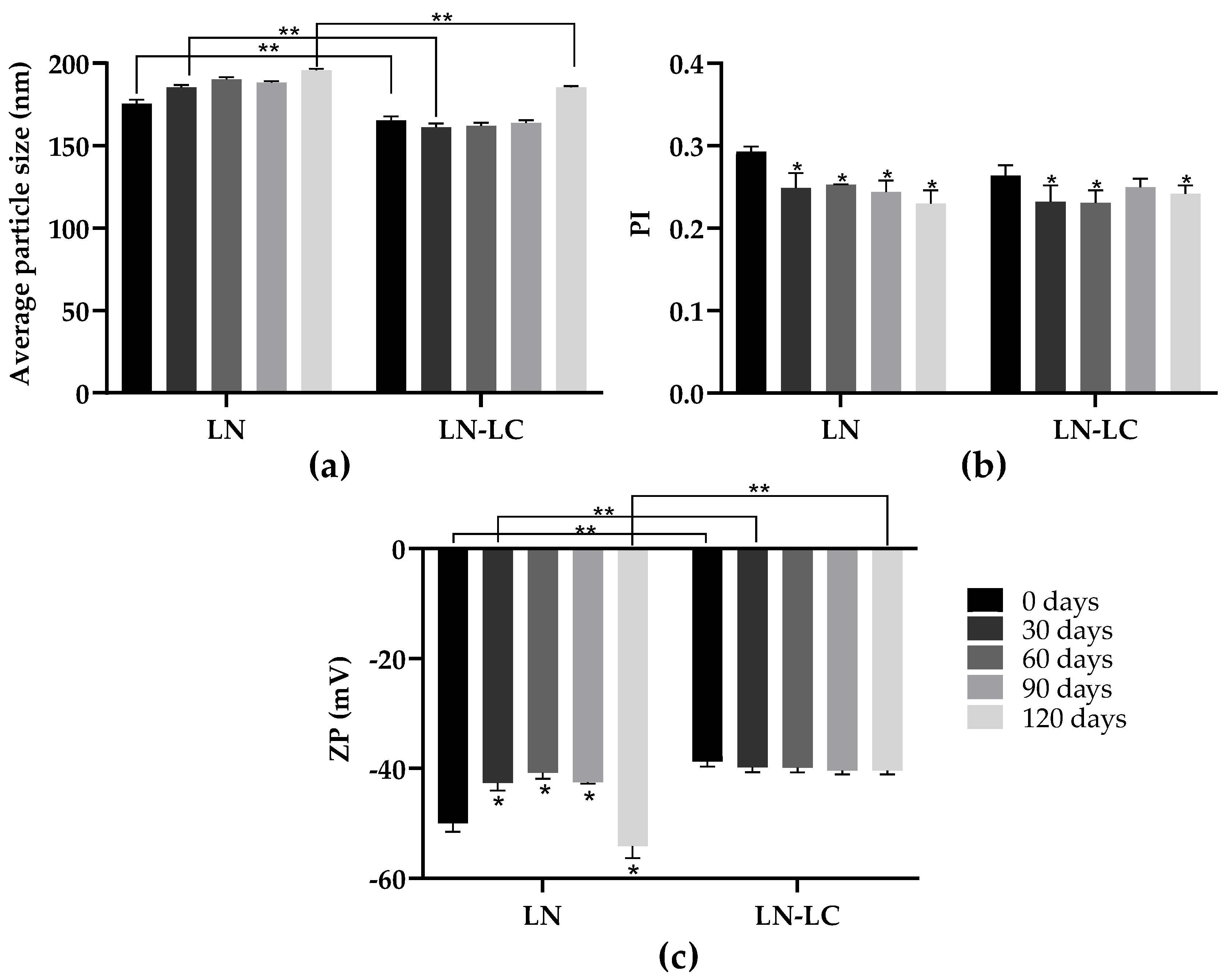
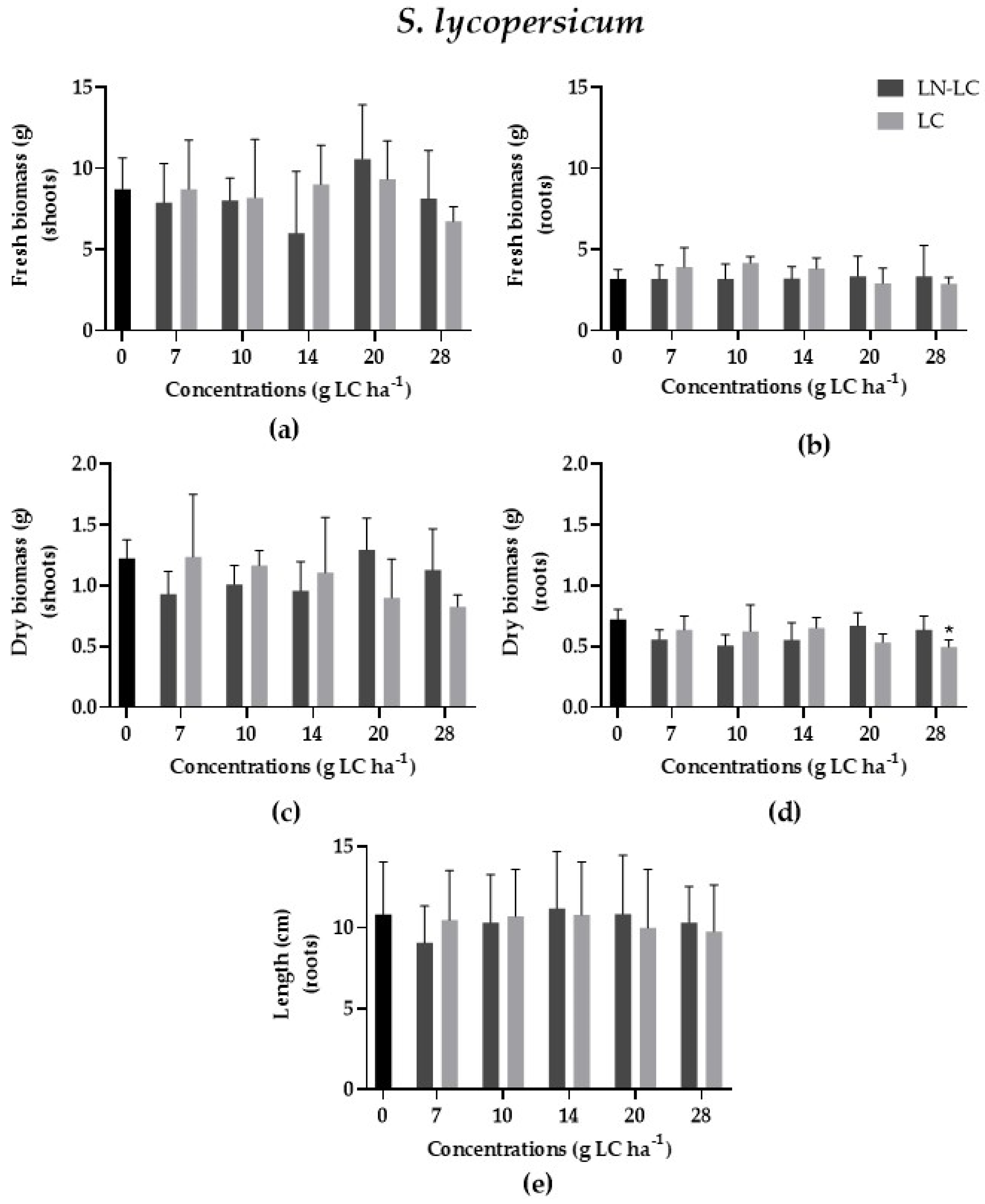
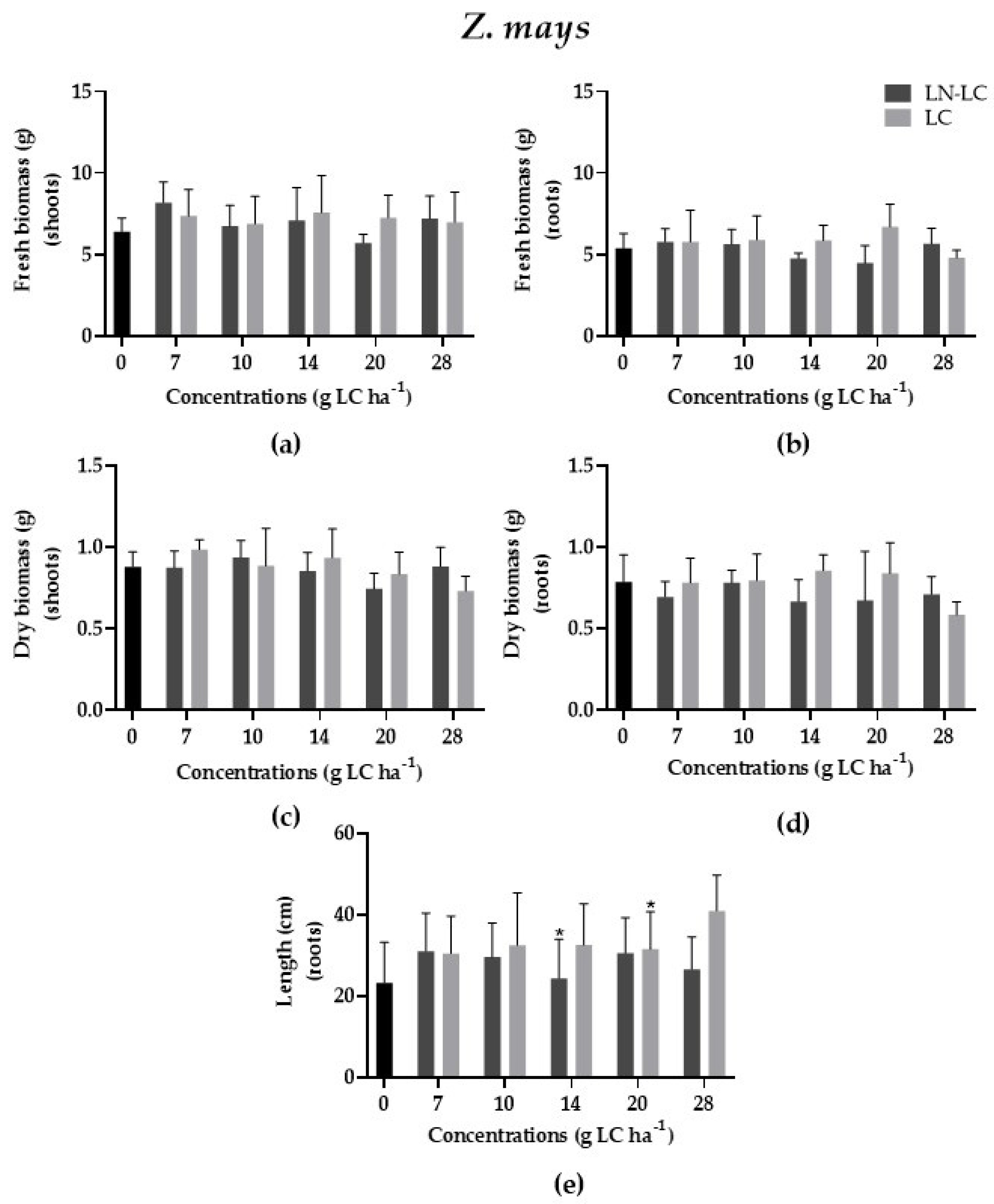

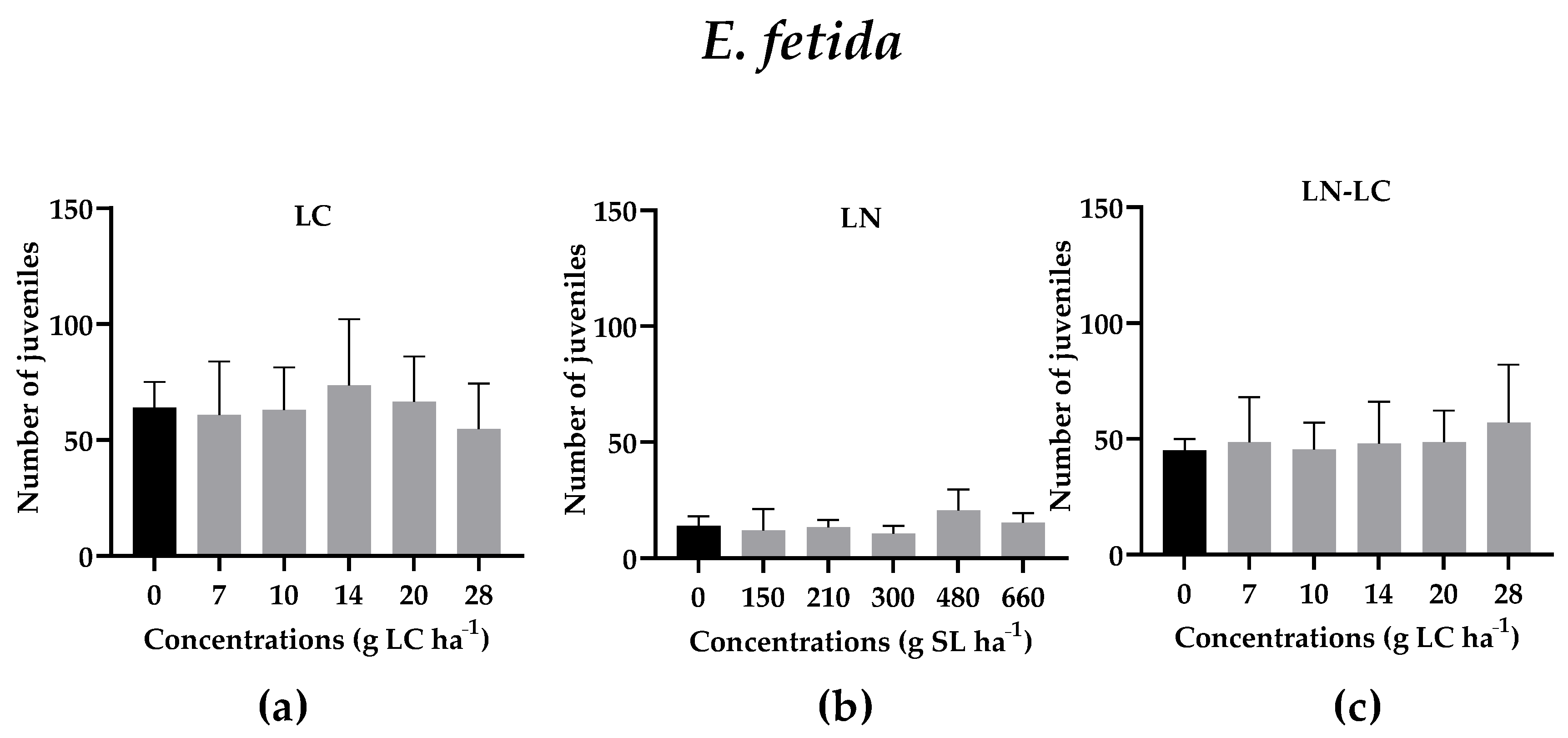


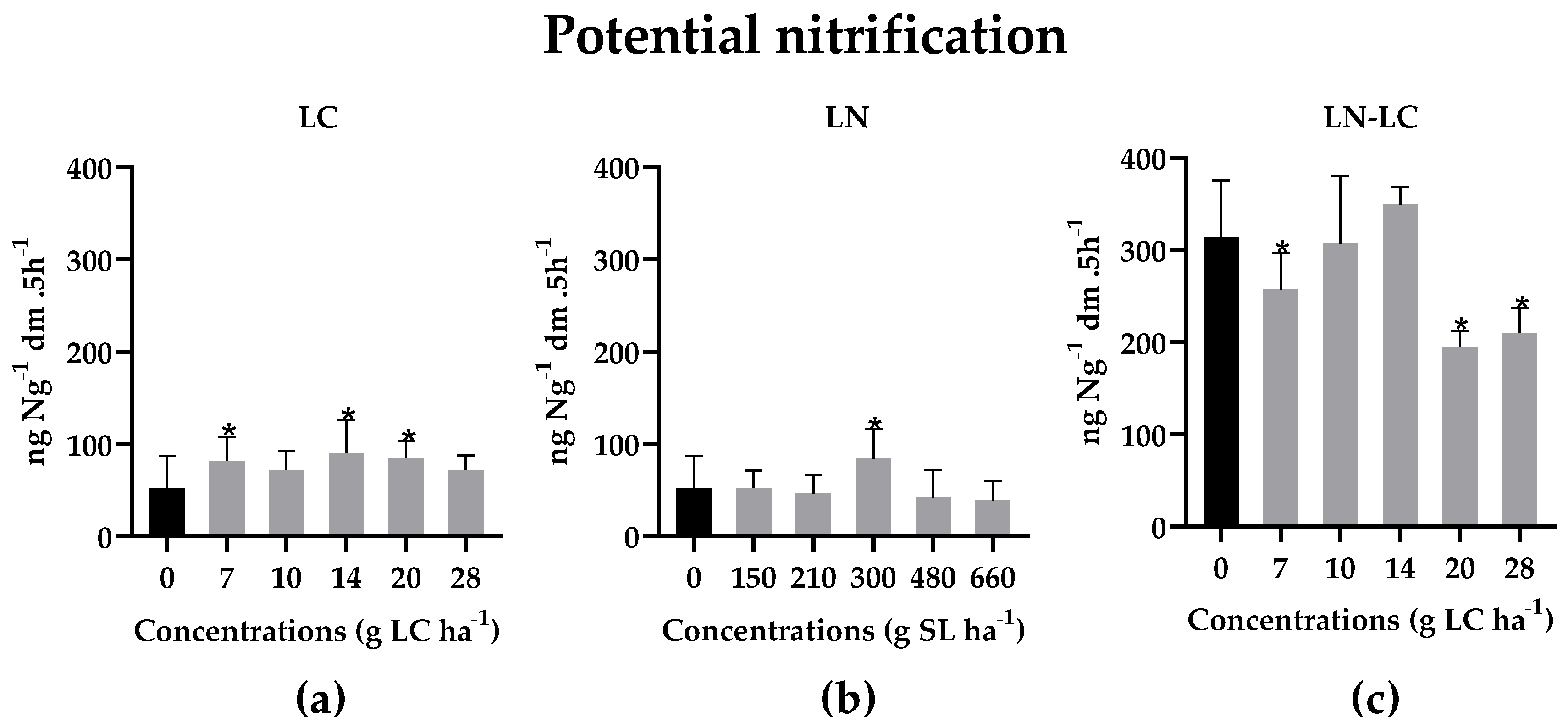
| Natural Soil | pH (H2O) | pH (KCl) | Conductivity (mS cm−1) | % OM | % WHCmax |
| 6.46 ± 0.020 | 5.39 ± 0.32 | 0.77 ± 0.045 | 5.21 ± 0.15 | 43.00 ± 0.15 |
| pH (KCl, 1M) | pH Values for the Natural Soil | ||
| Control soil | Soil containing LC | Soil containing LN | |
| pH (KCl, 1M) | 4.59 ± 0.006 | 4.61 ± 0.010 | 4.64 * ± 0.006 |
| Control soil | Soil containing LN–LC | ||
| 4.69 ± 0.006 | 4.67 * ± 0.012 | ||
| Soil Microbial Parameters | ||||||
|---|---|---|---|---|---|---|
| Dehydrogenase (µg TPF g−1dm h−1) | CM-Cellulase (µg GLU g−1dm 24 h−1) | Urease (µg NH4+ g−1dm 2 h−1) | Arylsulfatase (µg pNP g−1dm h−1) | Acid Phosphatase (µg pNP g−1dm h−1) | ||
| LC (g LC ha−1) | 0 | 0.71 ± 0.24 | 107.90 ± 33.28 | 0.99 ± 0.74 | 84.57 ± 10.89 | 234.19 ± 22.34 |
| 7 | 0.62 ± 0.24 | 128.27 ± 64.39 | 1.08 ± 0.94 | 88.69 ± 14.70 | 225.16 ± 10. 99 | |
| 10 | 0.82 ± 0.28 | 116.05 ± 52.04 | 1.37 ± 0.80 | 87.04 ± 8.50 | 231.52 ± 17.59 | |
| 14 | 0.65 ± 0.35 | 105.57 ± 37.94 | 3.03 ± 1.54 | 82.87 ± 6.75 | 158.41 * ± 59.82 | |
| 20 | 0.73 ± 0.16 | 94.83 ± 106.75 | 1.93 ± 2.22 | 90.57 ± 20.78 | 179.46 * ± 47.73 | |
| 28 | 0.83 ± 0.24 | 137.56 ± 31.04 | 1.85 ± 1.42 | 87.86 ± 8.00 | 159.38 * ± 34.37 | |
| LN (g SL ha−1) | 0 | 0.71 ± 0.24 | 107. 90 ± 33.28 | 0.99 ± 0.74 | 84.57 ± 10.90 | 234.19 ± 22.34 |
| 150 | 0.38 ± 0.25 | 118.48 ± 38.01 | 1.81 ± 1.14 | 74.42 ± 7.00 | 145.39 * ± 38.61 | |
| 210 | 1.68 * ± 0.38 | 82.83 ± 28.80 | 1.25 ± 0.80 | 76.17 ± 8.76 | 142.83 * ± 44.58 | |
| 300 | 1.75 * ± 0.36 | 74.50 ± 35.41 | 1.62 ± 1.30 | 76.74 ± 9.60 | 147.80 * ± 36.68 | |
| 480 | 0.48 ± 0.22 | 103.75 ± 42.01 | 2.74 * ± 1.34 | 72.56* ± 11.33 | 138.05 * ± 52.47 | |
| 660 | 0.33 * ± 0.20 | 136.13 ± 76.44 | 5.86 * ± 2.90 | 75.24 ± 7.33 | 157.91 * ± 45.49 | |
| LN–LC (g LC ha−1) | 0 | 2.16 ± 0.83 | 63.99 ± 27.73 | 4.92 ± 0.50 | 109.07 ± 22.63 | 234.06 ± 18.67 |
| 7 | 1.74 ± 0.62 | 71.65 ± 48.31 | 3.22 ± 0.43 | 92.38 ± 13.04 | 227.93 ± 14.64 | |
| 10 | 1.71 ± 0.64 | 99.73 ± 50.14 | 8.03 * ± 2.11 | 106.05 ± 17.68 | 229.61 ± 15.81 | |
| 14 | 1.71 ± 0.48 | 149.98 * ± 45.90 | 8.91 * ± 1.52 | 114.85 ± 18.86 | 224.07 ± 12.68 | |
| 20 | 1.33 ± 0.58 | 107.49 ± 45.92 | 7.61 * ± 1.92 | 86.41 * ± 12.30 | 210.37 * ± 18.85 | |
| 28 | 1.21 * ± 0.36 | 121.39 * ± 41.45 | 6.00 ± 1.20 | 78.01 * ± 15.53 | 190.02 * ± 34.93 | |
Publisher’s Note: MDPI stays neutral with regard to jurisdictional claims in published maps and institutional affiliations. |
© 2022 by the authors. Licensee MDPI, Basel, Switzerland. This article is an open access article distributed under the terms and conditions of the Creative Commons Attribution (CC BY) license (https://creativecommons.org/licenses/by/4.0/).
Share and Cite
Ganilho, C.; da Silva, M.B.; Paiva, C.; de Menezes, T.I.; dos Santos, M.R.; Pereira, C.M.; Pereira, R.; Andreani, T. Environmental Safety Assessments of Lipid Nanoparticles Loaded with Lambda-Cyhalothrin. Nanomaterials 2022, 12, 2576. https://doi.org/10.3390/nano12152576
Ganilho C, da Silva MB, Paiva C, de Menezes TI, dos Santos MR, Pereira CM, Pereira R, Andreani T. Environmental Safety Assessments of Lipid Nanoparticles Loaded with Lambda-Cyhalothrin. Nanomaterials. 2022; 12(15):2576. https://doi.org/10.3390/nano12152576
Chicago/Turabian StyleGanilho, Catarina, Márcia Bessa da Silva, Cristiana Paiva, Thacilla Ingrid de Menezes, Mayara Roncaglia dos Santos, Carlos M. Pereira, Ruth Pereira, and Tatiana Andreani. 2022. "Environmental Safety Assessments of Lipid Nanoparticles Loaded with Lambda-Cyhalothrin" Nanomaterials 12, no. 15: 2576. https://doi.org/10.3390/nano12152576
APA StyleGanilho, C., da Silva, M. B., Paiva, C., de Menezes, T. I., dos Santos, M. R., Pereira, C. M., Pereira, R., & Andreani, T. (2022). Environmental Safety Assessments of Lipid Nanoparticles Loaded with Lambda-Cyhalothrin. Nanomaterials, 12(15), 2576. https://doi.org/10.3390/nano12152576








